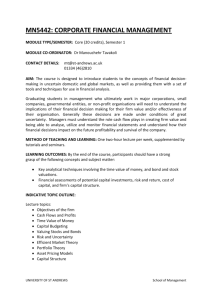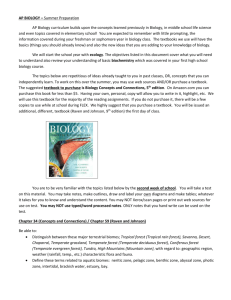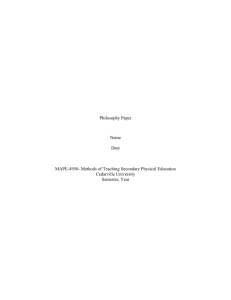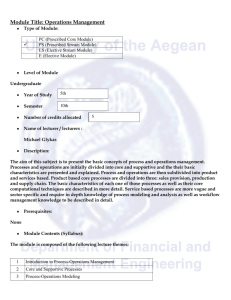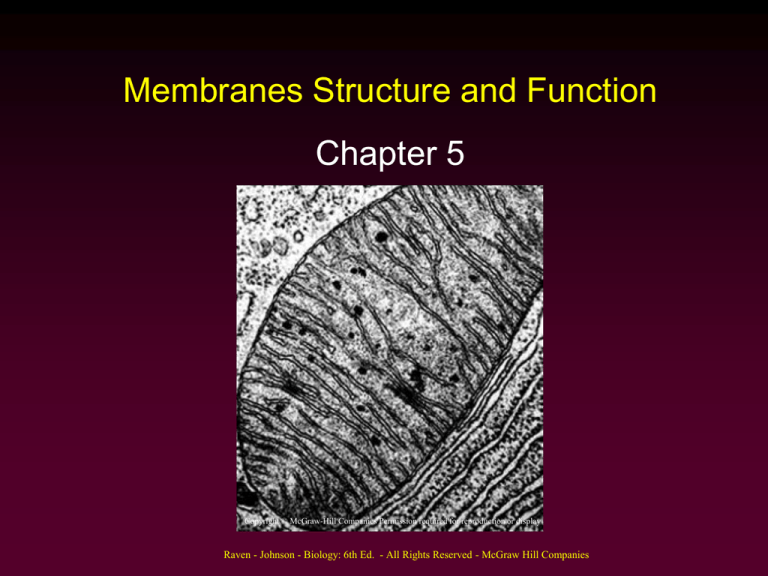
Membranes Structure and Function
Chapter 5
Copyright © McGraw-Hill Companies Permission required for reproduction or display
Raven - Johnson - Biology: 6th Ed. - All Rights Reserved - McGraw Hill Companies
Raven - Johnson - Biology: 6th Ed. - All Rights Reserved - McGraw Hill Companies
Plasma Membrane Consists of:
•
•
* nonpolar lipid bilayer impedes the passage
of water soluble substances
* degree of fluidity is determined by degree
of alignment of phospholipids.
Raven - Johnson - Biology: 6th Ed. - All Rights Reserved - McGraw Hill Companies
Plasma Membrane Consists of:
1. Lipid bilayer
•Phospholipids have a glycerol backbone with two
attached fatty acid chains.
Raven - Johnson - Biology: 6th Ed. - All Rights Reserved - McGraw Hill Companies
Plasma Membrane is:
1. Selectively Permeable – meaning that it allows
substances to cross the cell membrane passively
Examples: small non-charged molecules, CO2,
O2, glycerol, and alcohol.
Raven - Johnson - Biology: 6th Ed. - All Rights Reserved - McGraw Hill Companies
2. Proteins
•
* allows for passage of substances
Mosaic of proteins float in fluid lipid bilayer.
Transmembrane Proteins
Network of Interior Proteins
Cell Surface markers
Copyright © McGraw-Hill Companies
Permission required for reproduction or display
Raven - Johnson - Biology: 6th Ed. - All Rights Reserved - McGraw Hill Companies
Raven - Johnson - Biology: 6th Ed. - All Rights Reserved - McGraw Hill Companies
Cell Membrane Proteins
•
Six kinds of Membrane Proteins
Transporters – channels or carriers
Enzymes – rxns. occur in interior of cell
Cell Surface Receptors – detect chem.
messengers
Cell Surface Identity Markers – id cell
types
Cell Adhesion Proteins – connect cells
Cytoskeleton Attachments
Raven - Johnson - Biology: 6th Ed. - All Rights Reserved - McGraw Hill Companies
Raven - Johnson - Biology: 6th Ed. - All Rights Reserved - McGraw Hill Companies
How are proteins anchored on the cell
membrane?
-
•
•
Proteins contain polar and nonpolar regions
that allow them to be anchored.
Anchoring Proteins - Attached to membrane
surface.
Transmembrane Proteins
Anchor proteins
Channels and Carriers
Pores
Raven - Johnson - Biology: 6th Ed. - All Rights Reserved - McGraw Hill Companies
Passive Transport:
•
•
•
Diffusion
Facilitated Diffusion
Osmosis
Raven - Johnson - Biology: 6th Ed. - All Rights Reserved - McGraw Hill Companies
Diffusion
•
Random movement of substances from
regions of high concentration to regions of
lower concentration.(with the [gradient])
Continues until equilibrium reached.
Copyright © McGraw-Hill Companies Permission
required for reproduction or display
Raven - Johnson - Biology: 6th Ed. - All Rights Reserved - McGraw Hill Companies
Facilitated Diffusion
•
•
Each polar molecule transported across the
plasma membrane has its own type of channel
protein.
Selective permeability
Ions move across membrane in ion channels.
Direction of movement determined by
relative concentrations and voltage across
membrane.
Raven - Johnson - Biology: 6th Ed. - All Rights Reserved - McGraw Hill Companies
Facilitated Diffusion
•
Carrier proteins facilitate movement of solutes
across membrane by physically binding to
them on one side of the membrane and
releasing them on the other.
Driven by concentration gradients.
Copyright © McGraw-Hill Companies Permission required for reproduction or display
Raven - Johnson - Biology: 6th Ed. - All Rights Reserved - McGraw Hill Companies
Facilitated Diffusion
•
Three Essential Characteristics:
Specific
Passive
Saturates
Raven - Johnson - Biology: 6th Ed. - All Rights Reserved - McGraw Hill Companies
Osmosis
•
In an aqueous solution, both water and
solutes diffuse down a concentration
gradient.
Most solutes are not lipid soluble and thus
cannot cross membrane.
Water flows through aquaporins in
membrane.
- Net movement of water across a
membrane is termed osmosis.
Raven - Johnson - Biology: 6th Ed. - All Rights Reserved - McGraw Hill Companies
Osmosis
•
Osmotic Concentration - Concentration of all
solutes in a solution.
Hyperosmotic (Hypertonic)- Solution with
higher concentration of solutes.
Hypoosmotic (Hypotonic)- Solution with
lower concentration of solutes.
Isosmotic (Isotonic)- Osmotic
concentrations of both solutions are the
same.
Raven - Johnson - Biology: 6th Ed. - All Rights Reserved - McGraw Hill Companies
Osmosis
Copyright © McGraw-Hill Companies Permission required for reproduction or display
Raven - Johnson - Biology: 6th Ed. - All Rights Reserved - McGraw Hill Companies
Fig. 6.15
Raven - Johnson - Biology: 6th Ed. - All Rights Reserved - McGraw Hill Companies
Osmotic Pressure
•
•
•
Hydrostatic Pressure is caused by cytoplasm
pushing out against cell membrane.
Osmotic Pressure is the pressure necessary
to stop osmotic movement of water across a
membrane.
Mechanisms For Maintaining Osmotic Balance
Extrusion
Isomotic Solutions
Turgor
Raven - Johnson - Biology: 6th Ed. - All Rights Reserved - McGraw Hill Companies
Fig. 6.16
Raven - Johnson - Biology: 6th Ed. - All Rights Reserved - McGraw Hill Companies
Bulk Transport:
1. Endocytosis - Plasma membrane extends
outward and envelops food particles.
•Phagocytosis - “Cell eating” Particulate
form – discrete particles.
Copyright © McGraw-Hill Companies Permission required for reproduction or display
Raven - Johnson - Biology: 6th Ed. - All Rights Reserved - McGraw Hill Companies
Pinocytosis - “Cell drinking” Liquid form.
Raven - Johnson - Biology: 6th Ed. - All Rights Reserved - McGraw Hill Companies
Receptor-Mediated Endocytosis - Molecules
first bind to specific receptors on plasma
membrane before being engulfed
Raven - Johnson - Biology: 6th Ed. - All Rights Reserved - McGraw Hill Companies
2 Exocytosis - Discharge of material from
vesicles at cell surface; mechanism for secreting
many hormones, digestive enzymes, etc.
Copyright © McGraw-Hill Companies Permission required for reproduction or display
Raven - Johnson - Biology: 6th Ed. - All Rights Reserved - McGraw Hill Companies
Active Transport:
•
•
Movement of substances across a membrane
against their concentration gradients.
Requires input of energy.
Enables cell to take up additional molecules
of a substance already present in its
cytoplasm in concentrations higher than in
extracellular fluid.
Example: Sodium-Potassium Pump
moves 3 Na+ out and 2 K+ in
Raven - Johnson - Biology: 6th Ed. - All Rights Reserved - McGraw Hill Companies
Raven - Johnson - Biology: 6th Ed. - All Rights Reserved - McGraw Hill Companies
Raven - Johnson - Biology: 6th Ed. - All Rights Reserved - McGraw Hill Companies
Coupled Transport
•
Active transport that moves molecules
coupled with sodium ions or protons down
their concentration gradients
(Cotransport).
Establish the down gradient.
- Sodium-potassium or proton pump.
Trasverse the upgradient.
Cotransport
- Symport – ex. Na+ and sugar/a.a.
Countertransport
- Antiport – ex. Na+ inward and Ca++
outward
Raven - Johnson - Biology: 6th Ed. - All Rights Reserved - McGraw Hill Companies
Raven - Johnson - Biology: 6th Ed. - All Rights Reserved - McGraw Hill Companies
Raven - Johnson - Biology: 6th Ed. - All Rights Reserved - McGraw Hill Companies
Intercellular Adhesion
•
Cell clusters form long-lasting or permanent
connections with each other (cell junctions).
The nature of the connections determines
what the tissue is like.
Raven - Johnson - Biology: 6th Ed. - All Rights Reserved - McGraw Hill Companies
Raven - Johnson - Biology: 6th Ed. - All Rights Reserved - McGraw Hill Companies
Tight Junctions
•
Tight junctions connect plasma membranes
of adjacent cells in a sheet.
Prevent small molecules from leaking
between cells and through the sheet.
Effectively segregate proteins on opposite
sides of the sheet.
Fuse like a zipper
Ex. Prevent digestive enzymes from
seeping into blood
Raven - Johnson - Biology: 6th Ed. - All Rights Reserved - McGraw Hill Companies
Raven - Johnson - Biology: 6th Ed. - All Rights Reserved - McGraw Hill Companies
Anchoring Junctions
•
Anchoring junctions mechanically attach
cytoskeleton of one cell to cytoskeleton of
other cells, or to the extracellular matrix.
Desmosomes - Connect cytoskeletons of
adjacent cells; prevent cells subjected to
mechanical stress from pulling apart; they
are buttonlike thickenings of plasma
membrane
Hemidesmosomes - Anchor epithelial cells
to basement membrane.
Raven - Johnson - Biology: 6th Ed. - All Rights Reserved - McGraw Hill Companies
Desmosomes
Copyright © McGraw-Hill Companies Permission required for reproduction or display
Raven - Johnson - Biology: 6th Ed. - All Rights Reserved - McGraw Hill Companies
Anchoring Junctions
Cadherins - Connect actin frameworks of
cells in cadherin-mediated junctions.
Adherens - Connect actin filaments of one
cell with those of neighboring cells or with
extracellular matrix.
- Integrin proteins
Raven - Johnson - Biology: 6th Ed. - All Rights Reserved - McGraw Hill Companies
Communicating Junctions
•
•
•
Communication junctions pass chemical
signals directly from one cell to adjacent cells.
Establish direct physical connections.
Animals
Gap Junctions
- Connexons.
Plants
Plasmodesmata
Raven - Johnson - Biology: 6th Ed. - All Rights Reserved - McGraw Hill Companies
Copyright © McGraw-Hill Companies Permission required for reproduction or display
Raven - Johnson - Biology: 6th Ed. - All Rights Reserved - McGraw Hill Companies
The End
Copyright © McGraw-Hill Companies Permission required for reproduction or display
Raven - Johnson - Biology: 6th Ed. - All Rights Reserved - McGraw Hill Companies





